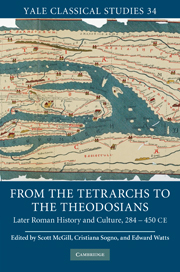Book contents
3 - Roman matchmaking
from PART I - POLITICS, LAW, AND SOCIETY
Published online by Cambridge University Press: 04 August 2010
Summary
“From ‘Romulus’ to Justinian patronage was a defining characteristic of what it meant to be Roman.” Far from disappearing in the late empire, patronage remained an essential tool for the recruitment of imperial administrators and happily coexisted (and, indeed, flourished) alongside the new system of the sale of offices. This has been argued by Peter Garnsey in this volume with special reference to socio-political advancement and the exercise of patronage in a legal context, and with the use in particular of letters of recommendation. My contribution will illustrate a related, but less studied aspect of patronage, namely, that concerning the activity of powerful patrons in arranging socially and economically advantageous matches on behalf of their protégés. The core evidence for my chapter is also provided by letters. In this respect, the letters of Symmachus are a treasure trove of first-hand information and a precious document of the continued importance of betrothal among the Roman upper classes in late antiquity. Furthermore, a comparison with the letters of Pliny and Augustine respectively will show the remarkable continuity of practices and ideals in both the arrangements of marriages and the exercise of this aspect of patronage.
The letters that I will discuss are best understood as a subgenre of the more familiar letter of recommendation, the epistula commendaticia, with which they share the same rhetorical strategies.
- Type
- Chapter
- Information
- From the Tetrarchs to the TheodosiansLater Roman History and Culture, 284–450 CE, pp. 55 - 72Publisher: Cambridge University PressPrint publication year: 2010
- 1
- Cited by



